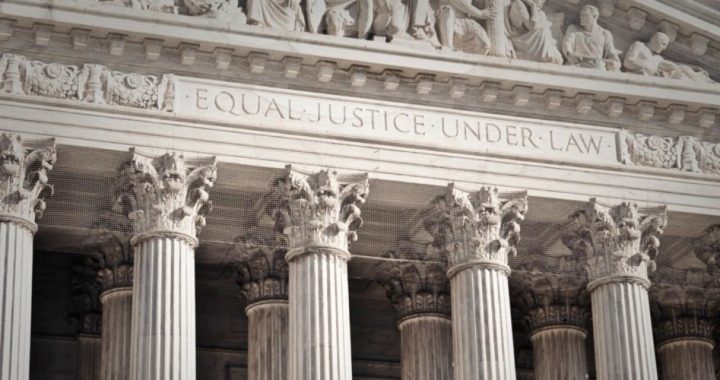
The first Monday in October annually begins another session of the U.S. Supreme Court. The justices who raised political storms in the last few years with controversial landmark decisions face no shortage of opportunities to do the same in the new term, including challenges pending to race-based affirmative action policies, the 1965 Voting Rights Act, and laws dealing with the emotionally charged issue of marriage for same-sex couples.
Early in 2010, the court kicked over a political hornets’ nest when it ruled 5-4 in Citizens United v. Federal Election Commission that restrictions on third-party independent political expenditures in the McCain-Feingold Campaign Reform Act are unconstitutional. And at the very end of last year’s session the justices generated a similar amount of political heat by upholding the individual mandate in the Patient Protection and Affordable Care Act, ruling that the requirement that individuals not otherwise covered purchase health insurance passed constitutional muster as an exercise of Congress’s power to tax and not, as the government had argued, under its power to regulate interstate commerce. The decision raised the hackles of conservatives who opposed the mandate, especially since the law itself said the mandate was not a tax.
Chief Justice John G. Roberts, Jr,, who provided the critical fifth vote and wrote the decision, surprised most court watchers who expected the 2006 George W. Bush appointee to rule the other way. Parties on all sides of the political and ideological spectrum will be closely watching Roberts to see if he is moving away from the court’s conservative bloc, where he has usually been in league with Justices Antonin Scalia, Clarence Thomas, and Samuel Alito.
The potential is there for the court to remain closely divided along ideological lines, as it has been in a large number of 5-4 decisions in recent years. Should Roberts be aligned once again with his conservative colleagues, Justice Anthony Kennedy, a 1987 Reagan appointee, will likely remain the swing vote, siding with the conservative faction more often than not, but sometimes providing the fifth vote for the liberal bloc comprised of Clinton appointees Ruth Bader Ginsburg and Stephen Breyer, and Obama nominees Sonia Sotomayor and Elena Kagan.
The court has scheduled an October 10 hearing on Fisher v. University of Texas, a challenge to race-based affirmative action policies in higher education. Abigail Fisher, a white woman, claims she was denied admission to the university because of her race. The university admits to taking race into account in selecting each year’s freshman class, but maintains it is but one of many means employed to ensure diversity in the student population.
The court in 2003 turned back a challenge to a similar policy as practiced by the University of Michigan. Justice Sandra Day O’Connor, who wrote the 5-4 decision, retired in 2006, while dissenting Justices Scalia, Kennedy, and Thomas remain on the Court. O’Connor’s seat is now occupied by Alito, another George W. Bush appointee, who harbors “substantially greater skepticism about the role of race in governmental decision-making, ” Thomas G. Goldstein, author of the SCOTUSblog, told the conservative weekly Human Events. Roberts has also expressed his disdain for what he has called “a sordid business, this divvying us up by race.”
The justices might also consider a new challenge to the Voting Rights Act, a landmark law of the civil rights era. The Court expressed reservations three years ago over a provision that requires federal approval of changes in election procedures in parts of the country with a history of racial discrimination, mainly the South. “We are now a very different nation” than the one that first enacted the law, Roberts wrote in a 2009 opinion joined by all but one of the eight other justices. “Whether conditions continue to justify such legislation is a difficult constitutional question we do not answer today,” he wrote. Congress has not amended the law since.
Speaking at the University of Colorado on September 19, Justice Ginsburg was asked about same-sex marriage. “I think it’s most likely that we will have that issue before the Court toward the end of the current term,” Ginsburg said. The court will likely take up the federal Defense of Marriage Act, which has been ruled unconstitutional by federal appeals courts in Boston and New York. The act defines marriage in federal law as the union of one man and one woman. Last year President Obama and Attorney General Eric Holder instructed the Department of Justice not to defend the law from challenges to its constitutionality and Justice Department lawyers have, in fact, weighed in on the other side, arguing in friend of the court briefs that the law unconstitutionally discriminates against same-sex couples. President Obama earlier this year announced he believes gay “marriages” should be legal.
Because of the Defense of Marriage Act, same-sex couples in states where such unions are recognized as legal marriages are denied federal benefits available to heterosexual couples. More than 1,000 federal laws are affected by the act, the New York Times reported, covering tax breaks, medical coverage and burial expenses, among other things.
The justices might also consider a challenge to a California law defining marriage as exclusively between one man and one woman. The law, adopted by California voters in a 2008 referendum, has been ruled unconstitutional by the Ninth Circuit Court of Appeals in San Francisco, where judges ruled that its adoption “served no purpose, and had no effect, other than to lessen the status and human dignity of gays and lesbians in California.”
The challenge was brought by attorney David Boies and former U.S. Solicitor General Theodore B. Olson, who argued that the law violated the state’s obligation under Amendment 14 to the U.S. Constitution to guarantee each citizen “equal protection of the laws.” The court may also decide cases involving the Fourth Amendment right to be secure from “unreasonable searches and seizures” and the Sixth Amendment guarantee of a defendant’s right to assistance by counsel. In Florida v. Jardines, the state is appealing a ruling by the Florida Supreme Court that police violated a defendant’s Fourth Amendment rights by using a police dog to smell for drugs at the door of a home where police suspected marijuana was being grown. The Florida high court decided in favor of the defendant, ruling that the police lacked probable cause for suspecting illegal activity.
In Missouri v. McNeely, the state has appealed a decision by the Missouri Supreme court that police violated a motorist’s rights by administering a blood test for intoxication without a warrant. The Missouri court rejected the state’s claim that there was no time get a warrant and test the driver’s blood before the alcohol in his system would have dissipated.
Ryan v. Gonzales raises the question of whether the defendant must be mentally capable of assisting his attorney in challenging a death penalty conviction, and Chaidez v. United States asks the Court to decide whether a 2010 ruling that criminal defense lawyers must advise clients who are here illegally that a guilty plea carries the risk of deportation applies to someone convicted prior to that ruling.
However these and other cases might be decided, the views of even the most sophisticated court watchers may be shaped less by whether the justices correctly applied the law than by whether the outcome is favorable to one cause or another. Charles Fried, who served as solicitor general in the Reagan administration and filed a brief in support of the ObamaCare law, offered a left-handed compliment to the Court for the decision it reached in that case, if not for the way it reached it. Fried, who now teaches at Harvard Law School, recalled that the chief justice at his 2006 confirmation hearing said a judge should be like an umpire, impartially calling balls and strikes.
“This is a court that under Chief Justice Roberts called a ball a strike, a strike a ball, but got the batter to base where he belonged,” Fried told the New York Times. “So who knows what to expect?”



